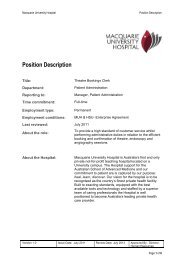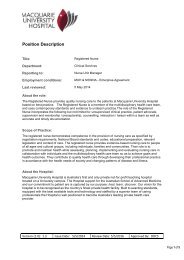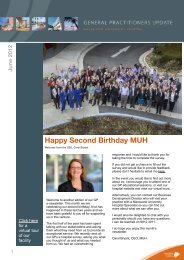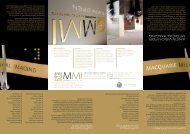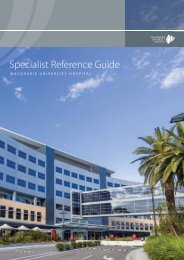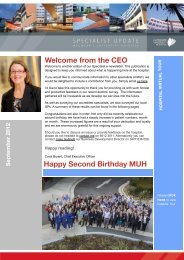Plenary Oral Presentations - Macquarie University Hospital
Plenary Oral Presentations - Macquarie University Hospital
Plenary Oral Presentations - Macquarie University Hospital
Create successful ePaper yourself
Turn your PDF publications into a flip-book with our unique Google optimized e-Paper software.
16 th International Meeting of the Leksell Gamma Knife ® SocietyMarch 2012, Sydney, AustraliaBE-30Gamma Knife Radiosurgery of Skull Base Meningiomas:Analysis of Long-Term ResultsJason SheehanDepartment of Neurological Surgery, <strong>University</strong> of VirginiaObjective: Skull base meningiomas are challenging tumors owing in part to their close proximity toimportant neurovascular structures. Complete microsurgical resection can be associated with significantmorbidity, and recurrence rates are not inconsequential. In this study, we evaluate the outcomesof skull base meningiomas treated with Gamma Knife radiosurgery (GKRS) both as an adjunct tomicrosurgery and as a primary treatment modality.Methods: We performed a retrospective review of a prospectively compiled database detailing theoutcomes of 290 patients with skull base meningiomas treated at the <strong>University</strong> of Virginia from1989 to 2006. All patients had a minimum follow-up of 24 months. There were 60 males and 230females with a median age of 55 years (range 19-85). One hundred sixty one patients were treatedwith upfront radiosurgery, and 129 patients were treated following surgical resection. Factors predictiveof new neurological deficit following GKRS were assessed via univariate and multivariateanalysis, and Kaplan-Meier analysis and Cox multivariate regression analysis was used to assessfactors predictive of tumor progression.Results: Patients had meningiomas centered over the tentorium (35; 12%), cerebellopontine angle(43; 15%), petroclival region (28; 10%), petrous region (6; 2%), clivus (40; 14%), and parasellar(138; 48%). The median follow-up was 6.3 years (range 2-18 years). The mean pre-radiosurgerytumor volume was 6.6 cc.251 patients (87%) displayed no change or decrease in tumor volume, and 39 (13%) displayed anincrease in volume. Kaplan Meier analysis demonstrated radiographic progression free survival at 3,5, and 10 years to be 99%, 95%, and 78% respectively. Pre-GKRS covariates associated with tumorprogression include age great then 65 (p=0.001) and decreasing dose to the margin of the tumor(p=0.05).At last clinical follow-up, 263 patients (91%) demonstrated no change or improvement in theirneurological condition and 27 patients deteriorated (9%). In multivariate analysis, the factorspredictive of new or worsening symptoms were increasing follow up (p=0.01), decreasing maximumdose (p=0.019), tumor progression (p=0.001), and parasellar, clival, or petrous location versuscerebellopontine angle, petroclival or tentorial location (p=0.018).Conclusions: GKRS offers a high rate of tumor control and neurological preservation in patients withskull base meningiomas. More favorable outcomes were observed for those receiving an optimalradiosurgery dose and harboring tumors located in a cerebellopontine angle, petroclival or tentoriallocation.3



